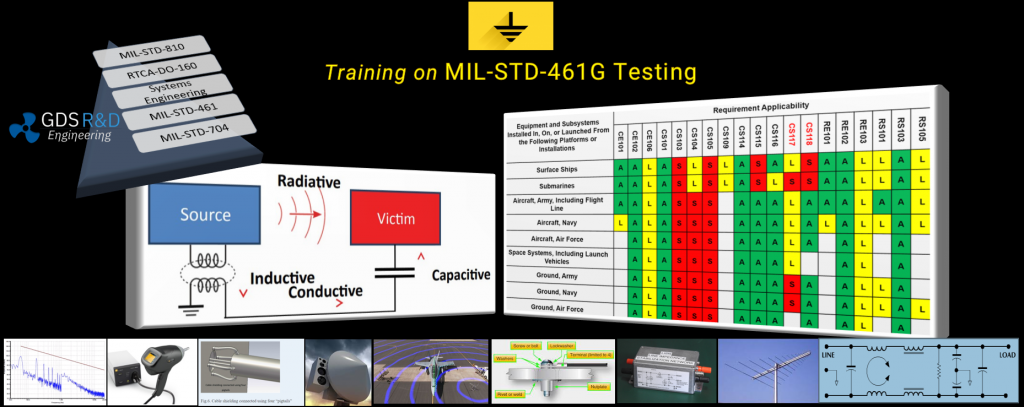
MIL-STD-461G EMI/EMC Online Training [EU EST Timezone]
April 30 @ 8:00 am – May 2 @ 12:00 pm

MIL-STD-461G Training on the EMI/EMC Testing of Military Equipment [Online/Live], with focus on:
MIL-STD-461G, Requirements for the Control of Electromagnetic Interference Characteristics of Subsystems and Equipment.
Including the overview of the relevant EMI/EMC test standards: MIL-STD-464, MIL-STD-704, MIL-STD-1275, and RTCA-DO-160G Power Input.
Training Type: International / Online
Satus: OPEN
Date: 30 April – 2 May, 2025 | Timezone: EST (European Standart Time) UTC+1.
Time: Day1/2: 08:30 – 16:30, Day 3: 08:00 – 12:00.
Click here to read all details about MIL-STD-461G training with detailed contents)
- Training Type: International / Online
- Satus: Seats are avaiable. Early bird (1-month in advance) registrations will receive 10% discount.
- Online training via ZOOM.
- Led by a live, U.S. based instructor (Dr Ismail Cicek) (PDF) (Download PDF)
- A usual 2.5 days of training schedule is as follows:
- Day 1: 08:00 – 11:30 | 13:00 – 16:30
- Day 2: 08:00 – 11:30 | 13:00 – 16:30
- Day 3: 08:00 – 11:30
- Time zone: EST (European Standart Time). UTC+1
- Ending time may vary+/-30 minutes depending on the length of the discussions.
- Course Material: English | Comm. Language: English
- Material: Registration includes all presentations and additional material (English) shared before the class.
- Attandance: The link for online class is distributed to registered trainees upon registration.
- Attendees will receive a Training Certificate.
- Training includes knowledge check quizzes, a competition type fun way or learning.
Training Contents
2.5 days of training covers the following topics:
- EMI/EMC Training, Opening Session
- General understanding of EMI and EMC.
- Introductory Design Considerations: Grounding, Bonding, and Shielding.
- MIL-STD-461G Standard General Overview
- Introduction & History
- MIL-STD-461: General overview, definitions, nomenclature, purposes, language, and scope
- MIL-STD-461 Contents Overview
- General and detailed requirements
- Selection of test methods and procedures based on the platform and equipment type
- MIL-STD-461G – CE Tests (Part I)
- Conducted Emissions Test Methods CE101, CE102, CE106
- Example Test Results and Report Reviews
- Q&As
- MIL-STD-461-G – CE Tests (Part II)
- Conducted Emissions Test Methods CE101, CE102, CE106
- Example Test Results and Report Reviews
- Q&As
- MIL STD 461G – CS Tests (Part I)
- Conducted Susceptibility Test Methods CS101, CS103, CS104, CS105, CS109
- Example Test Results and Report Reviews
- Q&As
- MIL STD 461G – CS Tests (Part II)
- Conducted Susceptibility Test Methods CS114, CS115, CS116, CS 117, CS 118
- Example Test Results and Report Reviews
- Q&As
- Product Development and Certification Process
- US DOD Systems Engineering V&V Processes, R&D Project vs. End Product
- Certification Process (MIL-STD-461, MIL-STD-464, MIL-HDBK 516, US DOD )
- USAF and US Army EMI/EMC Test and Certification Process
- FAA/EASA Part 21 ve Certification Process
- Documentation, Test Plans, and Test Reports
- Test Plan Examples
- Test Results and Risk Assessment
- Test Reports
- US DOD Data Items (DI) Forms and Data Item Descriptions (DID), governmental and non-governmental documentation
- MIL-STD-464 Standard
- MIL-STD-461 vs MIL-STD-464
- EMI/EMC Platform Level Requirements Review
- MIL-STD-464 Guides: Requirements Rationale and Lessons Learnt Items
- MIL-STD-461G RS Tests
- Radiated Susceptibility Test Methods RS101, RS103, RS105
- Example Test Results and Report Reviews
- Q&As
- MIL-STD-461G RE Tests
- Radiated Emissions Test Methods RE101, RE102, RE103
- Example Test Results and Report Reviews
- Q&As
- EMI/EMC & Equipment Design
- EMI/EMC and Equipment Design
- EMI/EMC Analysis Software Programs and Application Examples
- EMI/EMC Analysis Test Programs
- Additional Tests (RTCA-DO-160)
- Power Input, RTCA-DO-160G Section 16
- Magnetic Effect, RTCA-DO-160G Section 15
- Lightning Direct Effects, RTCA-DO-160G Section 23
- Other Relevant Test Standards, Brief Summary
- MIL-STD-464D Electromgnetic Environmental Effects, Requirements for Systems
- MIL-STD-704F Aircraft Electric Power Characteristics
- MIL-STD-1275E Interface Standard, Characteristics of 28 Volt DC Input Power to Utilization Equipment in Military Vehicles
- MIL-STD-1399 Interface Standard, Section 300, Part 1 Low Voltage Electric Power, Alternating Current
- MIL-STD-1399 Interface Standard, Section 300, Part 2 Medium Voltage Electric Power, Alternating Current
All MIL-STD-461G test sections are discussed and explained in detail, including
- The Purpose of the Test
- Test Configurations and General Requirements
- Test Requirements and Procedures
- EMI Test Chamber
- Test Setup: Test Setup (Tabletop) / Test Setup (Free Standing)
- Measurement Tolerances
- Interpretation of the Test Results and Example Test Report Reviews
- Issues that might be observed with recommendations (based on design experience).
Instructors
The main instructor of the training is Dr Ismail Cicek. An Avionics Chief Engineer (EE) who is also a Certified Verification Engineer (FAA/EASA) also assists the trainings. Our experienced test personnel also becomes avialable for demonstrations and discussions.
A Certified Verification Engineer (CVE) iaw FAA/EASA and with 18 years of experience. He has worked as the avionics systems chief engineer in product development of avionics systems. He is also experienced in the product testing per environmental and EMI/EMC standards and FAA/EASA certification processes.
Our experienced personnel also support our training programs. They are actively participating in the environmental testing of products.
Registration
We provide both face-to-face and online training programs. For registration to a course or custom training requests for your organization, please get in touch with us.
To secure your spot in our training class, please send an email including your full name, your affiliated organization, contact information, and the name and date of the training you wish to attend. We look forward to having you!
| US Offices: | GDS Global Office (EU/TR): |
|---|---|
| Dayton, OH. | Mountainview, CA Ph. +1 (937) 912-1220 | ITU ARI Teknokent | GTU Teknopark Ph. +90 546 934 95 99 |